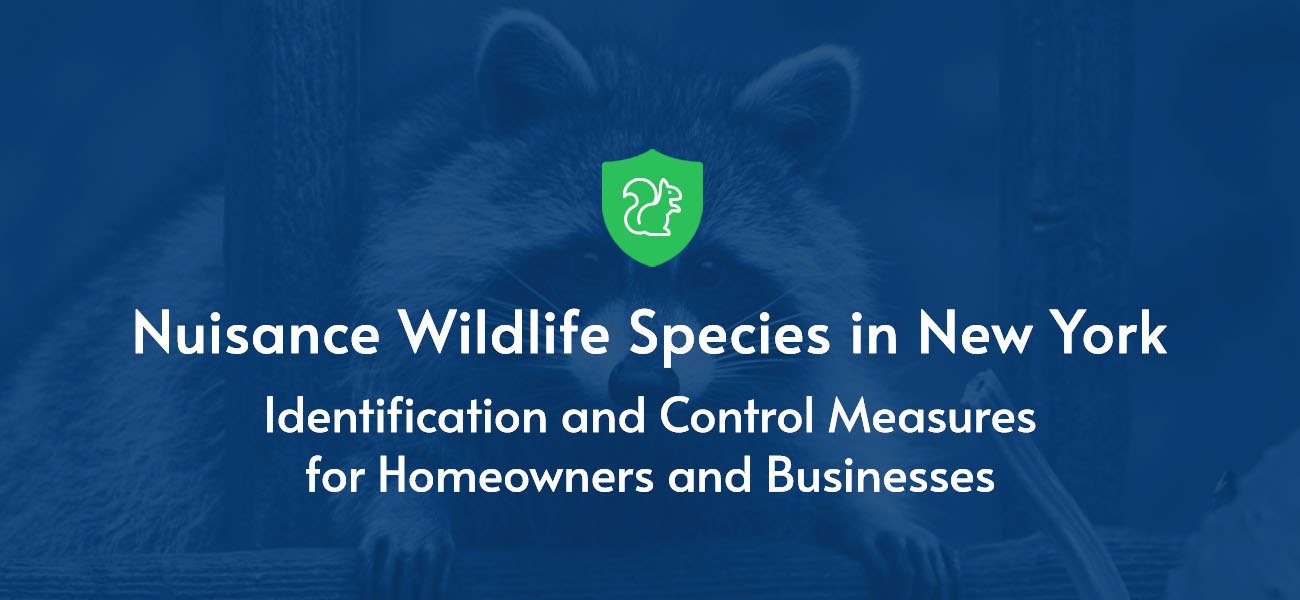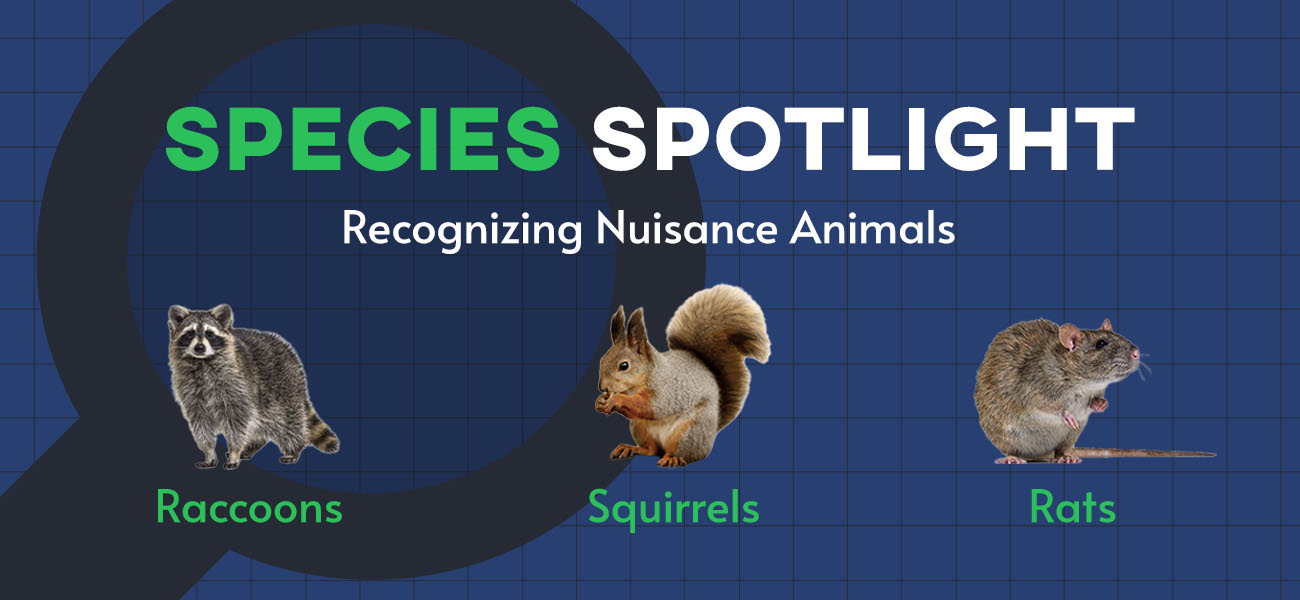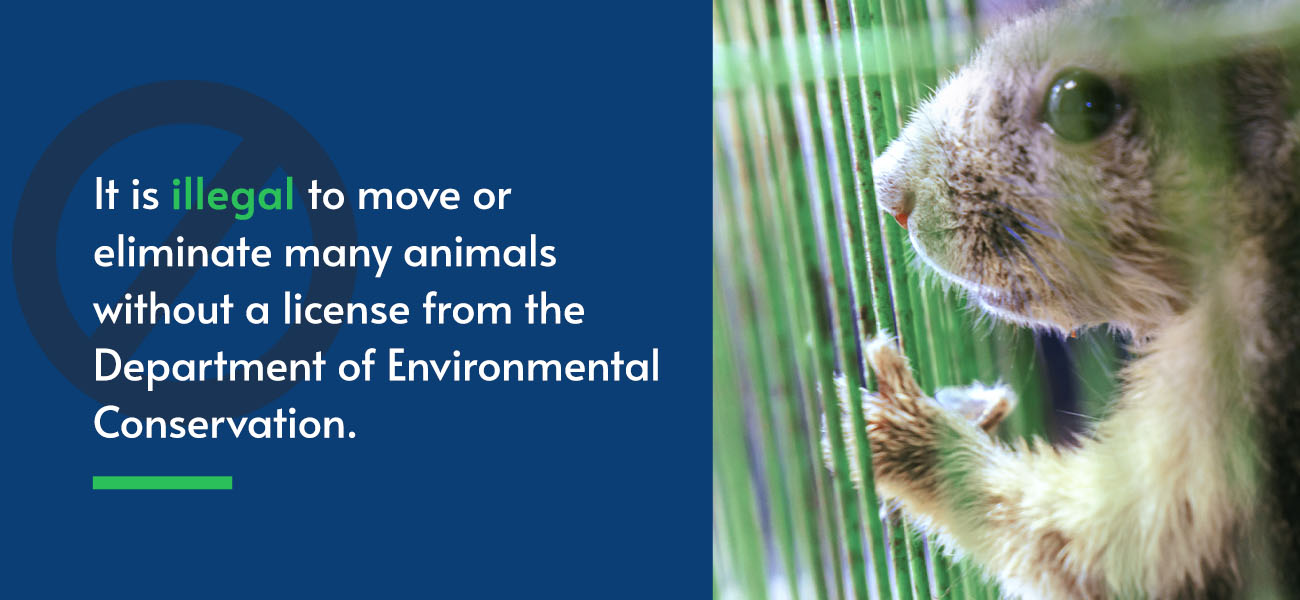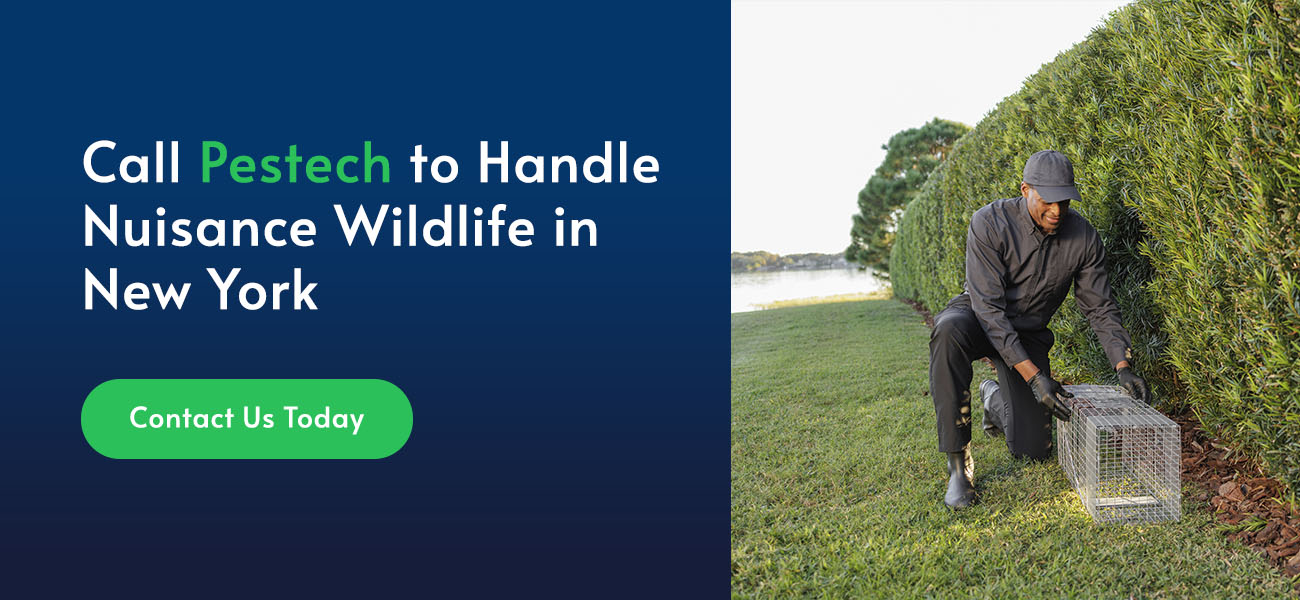Nuisance Wildlife Species in New York — Identification and Control Measures for Homeowners and Businesses

Animals and insects in their natural habitat are usually not a problem. Sadly, human-caused habitat loss is a threat to wildlife species’ survival. Driven out of their homes, many animals gravitate to cities and towns searching for food.
Accessible garbage bags in homes and restaurants provide an accessible food source for pests. During the winter or breeding season, wildlife can seek shelter and protection in any building with entry — and most pests can fit through tiny spaces.
Many wild animals in NYC carry diseases that can harm the pets and people they live alongside. All this easy access to food and shelter means higher reproduction rates, so the pest problem keeps growing. To keep living conditions sanitary, it’s imperative to identify and manage pests that invade human living spaces.
Pestech Pest Solutions expertly serves property owners in New York while maintaining ecological balance and ethically removing pests. Keep reading to learn more about identifying and controlling pest populations in New York.
Identifying Common Nuisance Wildlife Species in New York Neighborhoods
When people think about pests in New York, they may picture animals like rats. However, many other kinds of wildlife have adapted to city life across New York state — including raccoons, squirrels, rabbits and coyotes.
Understanding New York’s Diverse Wildlife Habitat
In New York City, diverse wildlife habitats include wetlands, forests and meadows in the parks and suburbs. The more rural parts of the state are home to many stunning state parks with forests and lakes.
Due to habitat diversity, the state has a varied wildlife population. Some species gravitate toward cities, while others stay closer to nature. For example, bears need space and are unlikely to wander onto a busy urban street.
If you’re wondering what wild animals live in New York, common mammals include deer, coyotes, bears, squirrels, foxes, beavers and moose. Many bird, insect and reptile species also live in our state. While some animals prefer their natural habitat, others — like rats — have adapted quite well to highly populated areas.
Species Spotlight — Recognizing Nuisance Animals

Some of the most prevalent nuisance animals in New York include raccoons, squirrels and rats. Keep reading to learn more about each of these animals and why they can become a problem for people.
- Raccoons: This animal lives across New York and is active at night. Raccoons are famous for going through trash, but they’ll eat everything from pet food to berries and seeds. Their babies are born in early spring and stay with their mothers until fall. Raccoons are a severe health concern in cities because they frequently carry rabies, which can make them aggressive. Other illnesses frequently carried by raccoons include canine distemper and roundworm.
- Squirrels: Because of a lack of natural predators, squirrels are also a problem in cities. They sometimes nest inside people’s homes, creating sanitation and structural issues. These rodents chew everything and can damage trees, gardens, buildings and more. Squirrels may also carry diseases like ringworm, typhus and tularemia. Squirrels have litters of about three to seven kits and may raise two litters a year.
- Rats: Because they’re small, nocturnal and reproduce so quickly, rats can be challenging to control in urban environments. These rodents have about six litters of babies a year, and each litter can contain eight pups or more. After nine weeks, new rats can start having families of their own. Rats may carry diseases like hantavirus, bubonic plague, salmonella and more. A foraging rat can consume any accessible food source in your building. They will rummage through garbage for food scraps, but rats also eat nuts, seeds and berries.
You can remove some animals from your property without a license, including red squirrels, woodchucks and rats. However, many species in New York require special permission to relocate, eliminate or hunt them.
Seasonal Wildlife Behavior and Identification
Wildlife species across New York have different seasonal breeding, hibernation and foraging patterns. New York nuisance wildlife are more likely to seek shelter inside buildings in cold weather or when having babies.
For example, rats tend to come inside to escape cold, rain and other adverse weather conditions. Location can also play a role in wildlife movement — people who live near a park or in older buildings may experience more trouble with nuisance wildlife.
How Climate Change Has Impacted New York’s Wildlife
Changes in New York’s climate also impact some species. Warmer weather is overheating already hot cities, and increased rainfall has led to flooding. The rising sea level along New York’s coast continues to threaten many ecosystems.
Climate change can influence wildlife in New York state. Natural disasters make it harder for some species to survive the winter. Unpredictable weather also impacts food sources for wildlife, affecting their foraging and breeding behavior.
Preventive Measures to Protect Your New York Home from Wildlife Intrusions
If you’re a homeowner in New York, you can take several practical steps to protect your property from wildlife intrusions. The best way to mitigate damage is by keeping animals out of your home and off your property. If pests have already infested your property, now is the best time to act.
Home and Property Inspections
You can catch a wildlife issue before it spirals out of control by scheduling regular property inspections. Immediately call a professional if you notice signs of animals inside your home or commercial building. Wildlife will try to hide, so open signs of a pest issue usually mean you’re dealing with a significant problem.
Implementing Physical Barriers and Repellents
The first step to wild-proof your home or business is to install physical barriers that keep animals out. Holes in siding, concrete or your roof provide a perfect entry point for critters to come inside. Fencing, netting and regular maintenance can help keep your building pest-free.
Another option is to use pest repellents. If you’re already experiencing a pest issue, these products can keep the problem from worsening. Fortunately, many eco-friendly options can protect your home without affecting the surrounding environment.
How to Create a Wildlife Management Plan for New York Residential Communities
Consider several factors if your goal is to manage nuisance wildlife for an entire community. First, assess what wildlife currently lives in the area and what potential problems residents experience. You can create the most effective plan to manage local wildlife by assessing different forms of risk.
The Framework for a Sustainable Management Plan
Before putting your plan in motion, ask community stakeholders for their feedback. With information and involvement, you can accomplish more for your community. Developing a comprehensive wildlife management strategy requires research, planning and adaptation.
Legal Considerations and Compliance
You must consider New York animal relocation laws before executing your plan. It is illegal to move or eliminate many animals without a license from the Department of Environmental Conservation. Endangered species will significantly change your plan to manage their populations.
Additionally, New York’s nuisance law prohibits you from releasing animals into parks or other recreational areas without special permission. This law is in place to ensure your problem doesn’t become someone else’s and that you treat animals as ethically as possible.
To create a strong community wildlife management plan, check the laws and connect with other prominent community members. As your plan develops, contact the appropriate agencies to ensure it is actionable and has a realistic timeline. You can accomplish more goals by breaking tasks down.
The Role of Professional Pest Solutions in Mitigating Wildlife-Related Damages
If wildlife has already infiltrated or damaged your property, you should act quickly and call a professional pest solutions service. Trained technicians can safely and legally remove animal intruders from your property without spreading disease.

Once experts have removed pests, they can repair property damage and install barriers to avoid future issues. Professionals know how to do their jobs quickly and effectively while staying compliant with state laws.
Pestech’s Approach to Wildlife Management and Control
At Pestech Pest Solutions, we improve human lives by eradicating pest problems. We’re local to Sullivan County, but continue to expand our services due to high demand. For over 25 years, we’ve removed pests with highly effective, eco-friendly methods.
Eco-Friendly Strategies for Controlling Nuisance Wildlife in Urban Areas
With careful planning, you can manage nuisance wildlife without damaging the environment or the particular species you’re dealing with. Taking early action to prevent property access is an effective way to keep wildlife from damaging property. However, there are many other eco-friendly approaches to handling pests.
The Importance of Sustainable Practices
Each action you take when interacting with nature impacts many species, and intervention can change your local ecosystem’s balance. Sustainable pest practices positively affect the ecology where you live.
Innovative Solutions for Urban Wildlife Challenges
There are many sustainable solutions for solving urban wildlife problems, including the following:
- Non-permanent insecticide sprays
- Baiting programs
- Catch-and-release programs
- Pest exclusion barriers
- Low-risk chemical control measures
Pest control should be environmentally sensitive to protect human life and the ecosystem. The methods listed above are only a few ways pest control services can improve sanitation without harming the environment.
Understanding the Bigger Picture — Wildlife in Residential Areas
In every environment, some species struggle and others thrive. Urban environments with unmonitored access to food and shelter can promote the growth of nuisance species. For example, an area with overflowing dumpsters may allow the rat population to increase exponentially.
The Ecological Impact of Nuisance Species
There is always a chain of predator and prey species within natural environments. Predators keep prey in check, and the abundance of prey impacts the number of predators in any given area. Often, predator populations are low in cities, leading to an overabundance of prey animals like rats, squirrels, insects and other small animals.
Coexistence With Urban Wildlife — Education and Awareness
Wildlife becomes a nuisance when it is too abundant for its location, invades human space or causes property damage. If you remove all pests from your property, you’ve only created room for new animals to move in. Being aware of the wildlife near you can go a long way to reduce conflicts.
To prevent wildlife issues, consider what could go wrong. For example, if you live in an area with squirrels, you should check your roof routinely for damage to ensure they cannot enter your attic. Awareness and preparation can reduce or eliminate nuisances.
FAQs — Addressing Common Concerns About Nuisance Wildlife in New York
If you still have questions, here are a few answers about nuisance animals in New York.
How Many Threatened Species Are in New York?
According to the New York Department of Environmental Protection, approximately 150 species in New York are endangered, threatened or of special concern. Here are several prominent examples.
- Cougar: Endangered
- Gray wolf: Endangered
- Timber rattlesnake: Threatened
- Canada lynx: Threatened
- Small-footed bat: Of special concern
There are legal restraints on relocating or harming these vulnerable species. Most well-known pests, like rats and cockroaches, are plentiful and not at risk. However, larger or lesser-known species may require special planning for removal.
What Animals Are Invasive to New York?
Invasive species aren’t originally native to the area and can disrupt local ecosystems. Here are a few examples of invasive species in New York:
- Asian longhorned beetle
- Eurasian boar
- Emerald ash borer
These species all adversely impact New York’s natural ecosystems. Immediately report any sightings to the New York Department of Environmental Conservation.
Call Pestech to Handle Nuisance Wildlife in New York
At Pestech Pest Solutions, we prioritize human health and environmental balance. Our eco-friendly services eliminate pests without adversely affecting the ecosystem where you live.
Contact us today to learn more about our services for homeowners, businesses and communities. We can answer any questions and support you in keeping your property healthy, safe and green.


